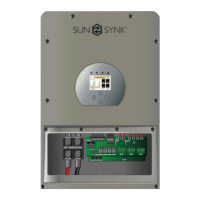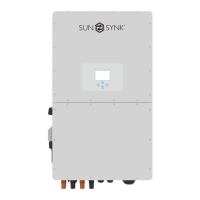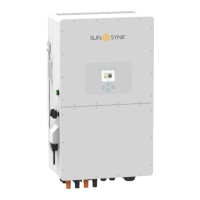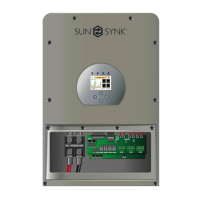SINGLE PHASE HI 10/12kW | User Manual44
Setting Up a Lithium Battery
To set up a lithium-ion battery, click on the BATTERY icon and visit the ‘Batt Type’ column.
What this page displays:
This information will only display if the ‘Lithium’ option is selected under ‘Batt Type’.
The type of communion protocol.
Approved batteries.
The batteries recommended for use with the Sunsynk systems are AGM Lead Acid or Lithium Battery Banks.
At its core, an AGM is still a lead-acid battery. AGM stands for Absorbent Glass Mat, which refers to the tech-
nology these devices use to create power. This berglass mat sits between the positive and negative lead
plates of your battery. Then, as the name suggests, it absorbs and holds the battery acid. That way, it doesn’t
freely ow around the battery.
State of Charge
Bulk: The bulk charge is the rst stage of a battery’s charging process, where the charger identies the
battery and its needs and then applies a high voltage to do the bulk of the charging. It involves about 80% of
the recharge. The properly sized charger will give the battery as much current as it will accept up to charger
capacity (25% of battery capacity in Amp hours).
Absorption: To fully charge a battery, a period of charging at a relatively high voltage is needed. This period
of the charging process is called absorption. This occurs when the charging of a battery has reached 80%
of its capacity. The remaining charge equals 20% approximately. It makes the charger hold the voltage at
the charger’s absorption voltage (between 14.1 VDC and 14.8 VDC, depending on charger set points) and
decreases the current until the battery is fully charged.
Float: The charging voltage is reduced to between 13.0 VDC and 13.8 VDC and held constant, while the
current is reduced to less than 1% of battery capacity. This mode can be used to maintain a fully charged
battery indenitely.
Equalisation: This is essentially a controlled overcharge that occurs at the end of the Bulk mode and the ab-
sorption phase and is called the ‘equalisation voltage’. However, technically, this phase has another function.
Higher capacity wet (ooded) batteries sometimes benet from this procedure, particularly the physically tall
batteries. The electrolyte in a wet battery can stratify over time if not cycled occasionally. In equalisation, the
voltage is brought up above the typical peak charging voltage well into the gassing stage and maintained for
a xed (but limited) period. This stirs up the chemistry in the entire battery, ‘equalising’ the strength of the
electrolyte and knocking o any loose sulphating that may be on the battery plates.

